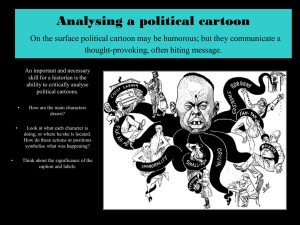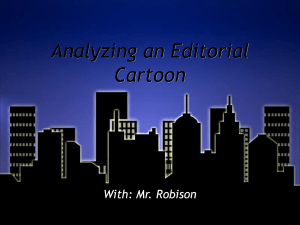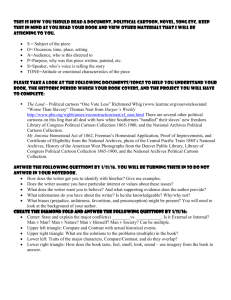10. Cartoon Analysis
advertisement
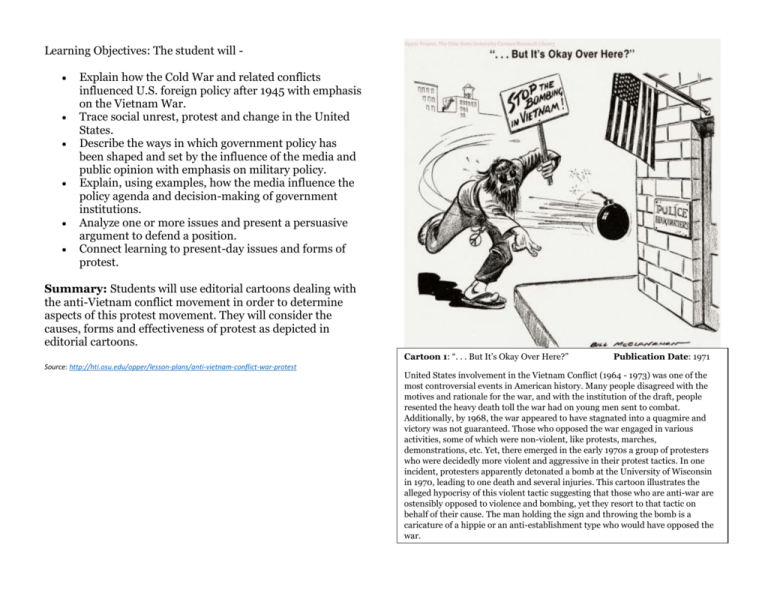
Learning Objectives: The student will Explain how the Cold War and related conflicts influenced U.S. foreign policy after 1945 with emphasis on the Vietnam War. Trace social unrest, protest and change in the United States. Describe the ways in which government policy has been shaped and set by the influence of the media and public opinion with emphasis on military policy. Explain, using examples, how the media influence the policy agenda and decision-making of government institutions. Analyze one or more issues and present a persuasive argument to defend a position. Connect learning to present-day issues and forms of protest. Summary: Students will use editorial cartoons dealing with the anti-Vietnam conflict movement in order to determine aspects of this protest movement. They will consider the causes, forms and effectiveness of protest as depicted in editorial cartoons. Cartoon 1: “. . . But It’s Okay Over Here?” Source: http://hti.osu.edu/opper/lesson-plans/anti-vietnam-conflict-war-protest Publication Date: 1971 United States involvement in the Vietnam Conflict (1964 - 1973) was one of the most controversial events in American history. Many people disagreed with the motives and rationale for the war, and with the institution of the draft, people resented the heavy death toll the war had on young men sent to combat. Additionally, by 1968, the war appeared to have stagnated into a quagmire and victory was not guaranteed. Those who opposed the war engaged in various activities, some of which were non-violent, like protests, marches, demonstrations, etc. Yet, there emerged in the early 1970s a group of protesters who were decidedly more violent and aggressive in their protest tactics. In one incident, protesters apparently detonated a bomb at the University of Wisconsin in 1970, leading to one death and several injuries. This cartoon illustrates the alleged hypocrisy of this violent tactic suggesting that those who are anti-war are ostensibly opposed to violence and bombing, yet they resort to that tactic on behalf of their cause. The man holding the sign and throwing the bomb is a caricature of a hippie or an anti-establishment type who would have opposed the war. Cartoon 2: Can you Hear the Same Program Closer to Home? Publication Date: Unknown Cartoon 3: The Threat of a Full-Time Job Publication Date: 1972 United States involvement in the Vietnam Conflict (1964 - 1973) was one of the most controversial events in American history. Many people disagreed with the motives and rationale for the war, and with the institution of the draft, people resented the heavy death toll the war had on young men sent to combat. Additionally, by 1968, the war appeared to have stagnated into a quagmire and victory was not guaranteed. This cartoon juxtaposes American anti-war protesters with those in the Soviet Union who also oppose the war in Vietnam. The cartoon suggests that anti-war protesters are undermining "Uncle Sam's" war in the same way that the USSR would by aiding the communists in North Vietnam. United States involvement in the Vietnam Conflict (1964 - 1973) was one of the most controversial events in American history. Many people disagreed with the motives and rationale for the war, and with the institution of the draft, people resented the heavy death toll the war had on young men sent to combat. Additionally, by 1968, the war appeared to have stagnated into a quagmire and victory was not guaranteed. Protesters often gathered outside of the White House, chanting and demonstrating. In this cartoon, President Richard Nixon and his Vice President Spiro Agnew observe a group of demonstrators and Agnew suggests that threatening the protesters with work would be an effective way to scare them off. This suggestion plays upon the stereotype of anti-war protesters as hippie, job-less drop-outs with no goals or education. Protesters actually came from all levels of society and all manner of backgrounds, but they were easily dismissed by mainstream society for their alliances with fringe groups and people. Cartoon 4: Viet-Conga Line Publication Date: 10/19/1967 United States involvement in the Vietnam Conflict (1964 - 1973) was one of the most controversial events in American history. Many people disagreed with the motives and rationale for the war, and with the institution of the draft, people resented the heavy death toll the war had on young men sent to combat. Additionally, by 1968, the war appeared to have stagnated into a quagmire and victory was not guaranteed. One of the most popular forms of protest that emerged during this period was the march or demonstration in which catchy sayings were chanted repeatedly. For instance, "Hell no! We won't go!" was a popular phrase, which referred to the anti-draft sentiment of the protesters, indicating that they wouldn't go to Vietnam if drafted (it could also refer to their unwillingness to leave a demonstration if police threatened to break it up). The title of this cartoon, "Viet-Conga Line," reveals the artist's belief that those who protested the war were, in effect, supporting the enemy (the Viet-Cong) in the war. Cartoon 5: Kissinger and ‘The Books’ Publication Date: 10/19/1967 United States involvement in the Vietnam Conflict (1964 - 1973) was one of the most controversial events in American history. Many people disagreed with the motives and rationale for the war, and with the institution of the draft, people resented the heavy death toll the war had on young men sent to combat. Additionally, by 1968, the war appeared to have stagnated into a quagmire and victory was not guaranteed. One of the most popular forms of protest that emerged during this period was the march or demonstration, usually in front of important government sites. This cartoon depicts protesters outside of National Security Adviser Henry Kissinger's office. Kissinger was a stalwart supporter of the conflict in Vietnam and refused to reconsider the course and strategies of the war, thus the cartoonist has depicted him as "sticking to the books" and ignoring the protesters. Cartoon 7: “Here They Come” Cartoon 6: Echoes of the Enemy Publication Date: Unknown United States involvement in the Vietnam Conflict (1964 - 1973) was one of the most controversial events in American history. Many people disagreed with the motives and rationale for the war, and with the institution of the draft, people resented the heavy death toll the war had on young men sent to combat. Additionally, by 1968, the war appeared to have stagnated into a quagmire and victory was not guaranteed this cartoon attempts to connect the anti-war protesters with the Soviet Union - suggesting that protesters "echo the enemy" and are therefore traitors who support the communist cause in the Vietnam conflict. Uncle Sam looks on from the bottom right corner. Publication Date: Unknown United States involvement in the Vietnam Conflict (1964 - 1973) was one of the most controversial events in American history. Many people disagreed with the motives and rationale for the war, and with the institution of the draft, people resented the heavy death toll the war had on young men sent to combat. Young men who were enrolled at a university or those who declared themselves as conscientious objectors (pacifists) could get deferments and avoid conscription. This led to large numbers of poor and working class young men filling the ranks in the army. Those who opposed the draft, but did not attend college or conscientiously object were left with little option. Many burned their draft cards to avoid conscription, while others fled to Canada as fugitives from the draft - socalled "draft dodgers." This cartoon depicts the border control officers on the Canadian side of the US border anticipating an influx of draft-dodgers.looks on from the bottom right corner.

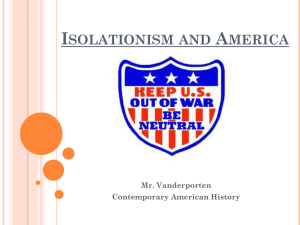

![Phrasal Verbs in Cartoons[2]](http://s2.studylib.net/store/data/005310718_1-897d1a57ddfabbe64c60ba43d0222e3b-300x300.png)
